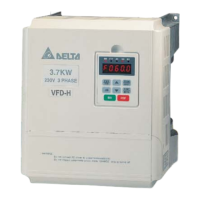How to troubleshoot OFF POWER LED on Delta VFD4A8MS21ANSAA?
- EEric WatsonAug 10, 2025
If the POWER LED is off, it indicates no power. Check if the connection between the CMM-PD02 and the AC motor drive is normal.

How to troubleshoot OFF POWER LED on Delta VFD4A8MS21ANSAA?
If the POWER LED is off, it indicates no power. Check if the connection between the CMM-PD02 and the AC motor drive is normal.
What to do if the Delta VFD4A8MS21ANSAA DC Drives NET LED flashes orange?
If the NET LED flashes orange, it means that the CMM-PD02 fails to communicate with the AC motor drive. To solve this, switch off the power and check whether the CMM- PD02 is correctly installed and normally connected to the AC motor drive.
Why is the NET LED on my Delta VFD4A8MS21ANSAA red?
A red light on the NET LED indicates that the CMM-PD02 is not connected to the PROFIBUS DP bus. To resolve this, connect the CMM-PD02 to the PROFIBUS DP bus.
What to do if the Delta DC Drives NET LED flashes red?
If the NET LED flashes red, it signifies an invalid PROFIBUS communication address. To fix this, set the PROFIBUS address of the CMM-PD02 between 1–125 (decimal).
Details about the AC drive's nameplate information, including input voltage, output voltage, frequency range, firmware version, certifications, and serial number.
Explanation of the model name structure for Delta's AC motor drives, detailing version type, model type, safety function, EMC function, protection level, and input voltage.
Information on how to interpret the serial number of the AC motor drive, including production number, production week, production year, and production factory.
Instructions on how to request after-sales service using a mobile device, including locating the service link label and using the QR code or website.
Explanation of the RFI jumper's function, its location on different frames, and precautions regarding its removal and installation.
Details minimum mounting clearances required for single drive, side-by-side horizontal, and zero stack installations, considering ambient temperature.
Provides airflow rates and power dissipation values for AC motor drives across different frames (A to F).
Illustrates the system wiring diagram for AC motor drives, detailing power input terminals, NFB or fuse, electromagnetic contactor, AC reactors, zero phase reactors, and brake modules.
Provides detailed wiring instructions for input and three-phase power, including connection to the digital signal common and output terminals.
Presents the main circuit diagram for one-phase and three-phase power input, showing terminals for DC reactor, brake resistor, and DC circuit.
Details specifications for main circuit wiring, including ring lug specifications, voltage rating, temperature resistance, and UL compliance requirements.
Provides wiring precautions and specifications for control terminals, including analog input, contact input, transistor output, and relay output terminals.
Lists brake resistors and brake units for AC motor drives, categorized by voltage and phase, including model, HP, kW, braking torque, resistor value, and current ratings.
Provides selection guidelines for Magnetic Contactors (MC) and Air Circuit Breakers (ACB) based on heavy duty input and output currents for various voltage models.
Details branch circuit fuse specifications (600 VAC) including input current and recommended fuse types (Class T JJS) for various models and voltage/phase configurations.
Explains the function and installation of AC input reactors and AC output reactors for improving power factor, reducing harmonics, and protecting the motor.
Describes zero phase reactors for suppressing interference at the main input or motor output, detailing casing types, dimensions, and models.
Explains the use of EMC filters to enhance EMC performance, reduce EMC problems, and lists recommended models with associated zero phase reactors and maximum motor cable lengths.
Provides models of EMC shield plates for use with shielded cables, including reference figures and dimensions.
Introduces the capacitive filter (CXY101-43A) for basic filtering and noise interference reduction, detailing its installation diagram, specifications, and dimensions.
Details conduit box installation for NEMA 1 / UL Type 1 kits, specifying conduit box models for different frames (A, B, C, D, E, F).
Provides fan models for different frames (A to F) and instructions for fan removal.
Explains the installation of the KPMS-LE01 keypad panel, including extension cable models, direct mounting on a plate, and mounting through a plate.
Details DIN-rail mounting accessories (MKM-DRB and MKM-DRC) for different frames (A, B, C), including screw specifications and torque values.












